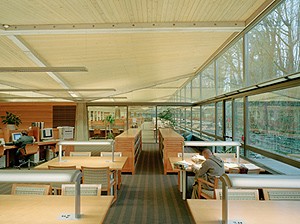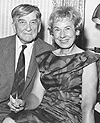Enhanced law school facilities benefit people, programs

Before Wood Hall opened in January, Loynd, a third-year law student, staked out study space in Aubrey R. Watzek Library. “Now I can give Watzek back to the undergraduates,” she says. “I love it here. I like the spaciousness, the height of the ceilings, and the automatic window shades.”
And that, says Tami Gierloff, associate director of Paul L. Boley Law Library, is the beauty of Wood Hall and the renovated Boley Library. “From private carrels to tables to casual seating to group study rooms, every student is finding his or her favorite space, and students can plug their laptops into any one of the 333 seats.”
Space, says Peter Nycum, professor of law and associate dean for library, is the best part of the new building. The 45,000 additional square feet increase the total area of the law school by 50 percent and offer more space to study, more space for books, more space for classrooms and offices, and—most important—more space to think.
“The new facilities provide the open space and the visual tranquility to truly promote the thought process,” Nycum emphasizes. “Wood Hall opens up vistas and unites the building with its forest environment. The magnificent sunsets were always there, but we couldn’t see them.”
“The original architecture was based on an intellectual separation of people and nature rather than on an expression of their interdependence,” says Jon Wiener, principal architect at Soderstrom Architects. “This building was an opportunity to show how nature and the built environment are intertwined.”
“Perched on a hillside, Wood Hall faces the forest with a curtain wall of glass curving from north to west, turning every room into part of the treetops,” writes architectural critic Randy Gragg in the Oregonian. He adds that the reading room inspires “occasional moments of drama, with 30-foot-plus ceilings and huge, curving acoustical panels scooping natural light deep inside the room.”
“I’ve never seen such facilities,” says Shen Dong, a second-year student who is studying contracts with Hui Wang in one of 10 new group-study rooms in Wood Hall. “The new library is a remarkable improvement over the old facility,” which Dong recalls as small, cramped, and full of people. “The old building had only three study rooms. Now there are 10 study rooms, and they are twice the size. And the new classrooms and two new seminar rooms give faculty more flexibility for scheduling classes, especially for evening students.”
Bill Funk, professor of law, uses state-of-the-art teaching technology in one of the two new classrooms on the first evening of his Environmental Law class. He projects a Web site on a large screen at the front of the class to show students how to register for electronic class discussion on the West Education Network. Then, to emphasize a point in his lecture, he projects a page onto the screen from the course textbook, Environmental Protection Law and Policy.
“The new classrooms have multiple ways to enrich the in-class learning experience,” comments Lydia Loren, associate professor of law.
“Built-in video, DVD, and laptop projection capabilities —along with document cameras that allow for the display of any text or image—permit professors and students to focus discussions and explore new methods of presenting materials,” she says.
“I have found that these options have reenergized my teaching and have challenged me to think creatively about facilitating learning using different methods of presentation.”
Wood Hall also includes new office suites for the school’s four law journals: Animal Law,Environmental Law, International Legal Perspectives, and The Journal of Small and Emerging Business Law.
“The law review offices, the classrooms, and the seminar rooms rank with facilities of the premier law programs in the nation,” says David Ellis, associate dean for administrative affairs and director of the business law program.
The two new computer labs and the area for the U.S. Patent and Trademark Depository are major improvements, he comments. And, he says, legal scholars will appreciate the new rare books room.
“Wood Hall is fabulous,” raves Janice Weis, assistant dean for environmental and natural resources law. “The building changes how we work together, the services we provide to students, and how we feel,” she says. “Wood Hall also sends a message. It says the law school is committed to its library, to its staff, to its clinics, and to its environmental program.”
Soderstrom Architects and Hoffman Construction deserve much of the credit for creating a “green” building that is winning awards and earning international recognition for efforts to minimize its impact on the environment.
Last August, Portland’s Office of Sustainable development, in partnership with the Portland Chapter of the American Institute of Architects, chose Wood Hall as one of 10 regional projects that exemplify “the latest and best in sustainable practices and technologies.” It was also selected to be part of an exhibit in conjunction with the Environ-Design6 conference in Seattle, one of the world’s largest and most influential conferences on sustainability.
“It’s wonderful to see a building that intentionally reflects the environmental sentiments of the student body—both in terms of visual appreciation and conservation efforts,” says Donna Maddux, student body president of the law school.
“It’s beautiful,” says Law School Alumni Board President David A. Ernst, shareholder in the Portland office of Bullivant Houser Bailey. “As alumni, we applaud the work that’s been done and the dean’s vision for the school. The design and construction exude quality.”
Wood Hall’s green features
Energy-saving features include:
- Lighting sensors that automatically activate window shades and lights
- A light scoop in the central staircase that brings in daylight
- State-of-the-art glass that reduces glare, allows heat inside during winter, and blocks sunlight in summer
- Cantilevered sun screens that reduce heat gain and heat loss
- Windows that open to support the natural ventilation system
- High-efficiency HVAC controls and equipment
Replenishable building materials include:
- Gypsum board and ceiling tiles made from recycled newsprint
- Carpets made at mills with reclamation programs
- Linoleum floors containing wood flour and linseed oil as natural ingredients
- Wood veneer from certified sustainable forests
- Stair treads made from fir trees cleared on site
- Structural steel and aluminum from recycled stock
Other green-friendly facts:
- When looking for a site with the least environmental impact, Soderstrom Architects chose the old service area/parking lot and designed a three-story building to keep the footprint as small as possible.
- Hoffman Construction of Oregon recycled 98 percent of construction debris.
- Forest plants grow on an “eco-roof” to slow rain runoff and to help the building blend with its natural surroundings.
The Woods’ legacy

Erskine was a legendary admiralty lawyer. Born in 1879 in Washington Territory, he lived briefly during his teens with Chief Joseph of the Nez Perce. Erskine graduated from the University of Oregon Law School in 1912, three years before it became Northwestern School of Law. He practiced law until age 98, and died in 1983 at 103.
Louise was born in Minnesota in 1909 and moved to New York City as a young girl. There she became one of the nation’s first women insurance brokers. She married Erskine in 1951 and used her business acumen to create investment groups throughout the Northwest.
“You don’t have to spend much time with Lou to know she has a mind of her own and speaks it now and then—but always with a twinkle in her eye,” says James Huffman, dean and Erskine Wood Sr. Professor of Law. “Our law school has had no better friend.”
More L&C Magazine Stories
Lewis & Clark Magazine is located in McAfee on the Undergraduate Campus.
MSC: 19
email magazine@lclark.edu
voice 503-768-7970
fax 503-768-7969
The L&C Magazine staff welcomes letters and emails from readers about topics covered in the magazine. Correspondence must include your name and location and may be edited.
Lewis & Clark Magazine
Lewis & Clark
615 S. Palatine Hill Road MSC 19
Portland OR 97219

